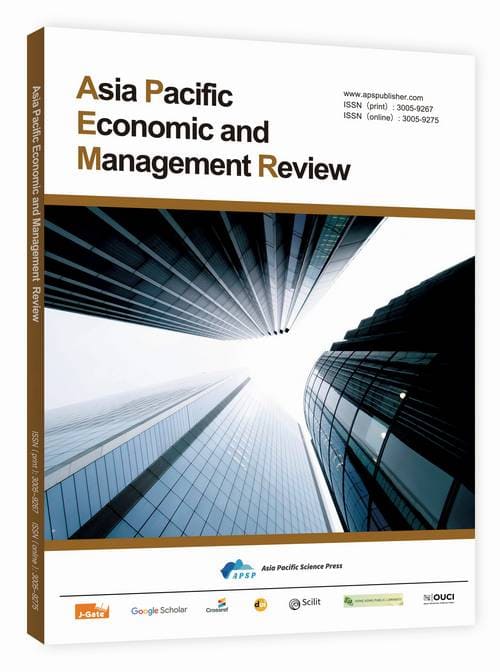Theoretical Mechanisms Linking the Digital Economy and Agricultural Economic Resilience: Construction and Analysis Based on a Quantitative Spatial Equilibrium Model
DOI:
https://doi.org/10.62177/apemr.v2i6.775Keywords:
Digital Economy, Agricultural Economic Resilience, Quantitative Spatial Equilibrium (QSE) Model, Data as a Production Factor, Digital–Infrastructure SynergyAbstract
This study aimed to construct a Quantitative Spatial Equilibrium (QSE) model that integrates digital factors and agricultural infrastructure, providing a unified theoretical framework for analyzing the underlying mechanisms of agricultural economic resilience. The model embedded a three-dimensional resilience system—resistance–adaptation–transformation—into consumer preferences and production functions. Within the agricultural context, it depicted the generation, exchange, and enabling mechanisms of data as a novel production factor, and elucidated its synergistic interaction pathways with both traditional and digital infrastructures. By incorporating the hat algebra approach, the model enabled counterfactual simulations of policy shocks in multi-regional and multi-sector economic systems, effectively mitigating parameter identification challenges.The theoretical contributions of this research lay in extending the application of quantitative spatial economics to the agricultural domain, identifying the sectoral heterogeneity of data-factor diffusion effects, and providing a formal analytical tool to explore the micro-foundations of how “digital–infrastructure” synergies enhance agricultural economic resilience. These findings established a methodological basis for subsequent empirical investigations and policy evaluations.
Downloads
References
Sun, Z. L., Kan, R., & Chen, J. L. (2025). Research on the Impact of Digital Economy on Agricultural Economic Resilience. Journal of Northeast University (Social Science Edition), 27(04), 37-48. DOI:https://doi.org/10.15936/j.cnki.1008-3758.2025.04.005
Jia, J. R. (2025). Measurement of Agricultural Economic Resilience and Its Influencing Factors under the Background of Digital Economy. Journal of Henan University of Animal Husbandry and Economy, 38(03), 22-26. DOI:https://doi.org/CNKI:SUN:HNSY.0.2025-03-004
Finger, R. (2023). Digital innovations for sustainable and resilient agricultural systems. European Review of Agricultural Economics, 50(4), 1277-1309.DOI:https://doi.org/10.1093/erae/jbad021.
Guo, Z., & Zeng, Y. (2024). The Theoretical Logic and Practical Path of Effective Supply of Digital Agricultural Infrastructure. Journal of Nanjing Agricultural University (Social Sciences Edition), 24(06), 176-186. DOI:https://doi.org/10.19714/j.cnki.1671-7465.2024.0084
Goldfarb, A., and Tucker, C. (2019). Digital Economics. Journal of Economic Literature, 57(1): 3-43. DOI: 10.1257/jel.20171452
Li, D. H., & Xu, S. W. (2022). Research on the Current Situation and Prospects of New Agricultural and Rural Infrastructure Construction. Forum on Science and Technology in China, (02), 170-177. DOI:https://doi.org/10.13580/j.cnki.fstc.2022.02.008
Aker, J. C., et al. (2016). Information from Markets Near and Far: Mobile Phones and Agricultural Markets in Niger. American Economic Journal: Applied Economics, 8(2): 1-29. DOI: 10.1257/app.2.3.46
Wang, Z. L., Zeng, H., & Luo, R. (2023). Does Digital Infrastructure Construction Enhance Agricultural Economic Resilience?. Study and Practice, (12), 33-44. DOI:https://doi.org/10.19624/j.cnki.cn42-1005/c.2023.12.006.
Donaldson, D., and Hornbeck, R. (2016). Railroads and American Economic Growth: A 'Market Access' Approach. Quarterly Journal of Economics, 131(2): 799-858. DOI:https://doi.org/10.1093/qje/qjw002.
Béné, C., et al. (2020). Resilience as a policy narrative: potentials and limits in the context of urban planning. Climate and Development, 12(1): 1-15. DOI:https://doi.org/10.1080/17565529.2017.1301868.
Sun, J. L., Li, D. H., Xu, S. W., Wu, W. B., & Yang, Y. P. (2021). Research on the Development Strategy of Agricultural Big Data and Information Infrastructure. Strategic Study of CAE, 23(04), 10-18.
Urraca-Ruiz, A., & Da Silva Lima, S. (2025). Coevolution of technical change and income inequality in developed and developing countries. Economics of Innovation and New Technology, 34(6), 817-841.DOI:https://doi.org/10.1080/10438599.2024.2377597.
Feng, J., & Qi, S. (2024). Digital infrastructure expansion and economic growth in Asian countries. Journal of Business and Economic Options, 7(2), 27-32..
Zhou, J., Raza, A., & Sui, H. (2021). Infrastructure investment and economic growth quality: empirical analysis of China’s regional development. Applied Economics, 53(23), 2615-2630.DOI:https://doi.org/10.1080/00036846.2020.1863325.
ZHANG, J., & Chen, S. H. E. N. (2021). Impact of climate change on maize yield in China from 1979 to 2016. Journal of Integrative Agriculture, 20(1), 289-299.DOI:https://doi.org/10.1016/S2095-3119(20)63244-0.
Allen, T., & Donaldson, D. (2022). The Geography of Path Dependence. Quarterly Journal of Economics, 137(3), 1613-1679.
Béné, C. (2020). Resilience of local food systems and links to food security – A review of some important concepts in the context of COVID-19 and other shocks. Food Security, 12(4), 805-822. DOI:https://doi.org/10.1007/s12571-020-01076-1.
Acemoglu, D., & Restrepo, P. (2022). Tasks, Automation, and the Rise in U.S. Wage Inequality. Econometrica, 90(5), 1973-2016. DOI:https://doi.org/10.3982/ECTA19815
Jones, C. I., & Tonetti, C. (2020). Nonrivalry and the Economics of Data. American Economic Review, 110(9), 2819–2858. DOI:10.1257/aer.20191330
Adler, M., et al. (2023). Exponential-Growth Bias and Lifecycle Consumption. Journal of the European Economic Association, 21(2), 722–759. DOI:https://doi.org/10.1111/jeea.12149.
Berger, M., et al. (2021). The Digital Transformation and the Transformation of Value Chains: A Developing-Country Perspective. World Bank Research Observer, 36(2), 256-292. DOI:https://doi.org/10.1111/glob.12388
Bryan, G., & Morten, M. (2019). The Aggregate Productivity Effects of Internal Migration: Evidence from Indonesia. Econometrica, 87(6), 2079-2038. DOI:https://doi.org/10.1086/701810.
Laget, E., Osnago, A., Rocha, N., & Ruta, M. (2020). Deep trade agreements and global value chains. Review of Industrial Organization, 57(2), 379-410.DOI:https://doi.org/10.1007/s11151-020-09780-0.
Dekle, R., Eaton, J., & Kortum, S. (2007). Unbalanced Trade. American Economic Review, 97(2), 351-355. DOI: 10.1257/aer.97.2.351 DOI:10.1257/aer.97.2.351
Acemoglu, D., & Restrepo, P. (2022). Tasks, automation, and the rise in US wage inequality. Econometrica, 90(5), 1973-2016. DOI:https://doi.org/10.3982/ECTA19815
Jones, C. I., & Tonetti, C. (2020). Nonrivalry and the Economics of Data. American Economic Review, 110(9), 2819–2858. DOI:10.1257/aer.20191330
Guo, N., Lyu, T. X., & Zong, H. L. (2025). The Impact of Agricultural Digitalization on Agricultural Economic Resilience. Chinese Journal of Eco-Agriculture (Chinese and English), 33(01), 178-189.DOI:10.12357/cjea.20240607
Donaldson, D., & Hornbeck, R. (2016). Railroads and American Economic Growth: A 'Market Access' Approach. Quarterly Journal of Economics, 131(2), 799-858.DOI:https://doi.org/10.1093/qje/qjw002
Zhang, J. C., & Yang, Z. X. (2025). Research on the Impact of Digital Economy on Agricultural Economic Resilience in Shandong Province. Rural Scientific Experiment, (01), 15-17.DOI: https://doi.org/10.20264/j.cnki.rse.2025.01.007
Liu, W. J., & Liu, B. Q. (2024). The Path of Rural Digital Infrastructure Construction Empowering Rural Revitalization: Based on the Perspective of Integration of Digitalization and Modern Agricultural Industries. Journal of Shanxi University of Finance and Economics, 46(10), 72-88. DOI:https://doi.org/10.13781/j.cnki.1007-9556.2024.10.006
Tombe, T., & Zhu, X. (2019). Trade, migration, and productivity: A quantitative analysis of China. American Economic Review, 109(5), 1843-1872. DOI: 10.1257/aer.20150811
Jones, Charles I., and Christopher Tonetti. 2020. Nonrivalry and the Economics of Data.American Economic Review 110 (9): 2819–58.DOI: 10.1257/aer.20191330.
Guo, Z., & Zeng, Y. (2024). The Theoretical Logic and Practical Path of Effective Supply of Digital Agricultural Infrastructure. Journal of Nanjing Agricultural University (Social Sciences Edition), 24(06), 176-186. DOI:https://doi.org/10.19714/j.cnki.1671-7465.2024.0084
Zhang, Y. C., & Dai, R. X. (2018). The Impact of Rural Infrastructure on Agricultural Economic Growth: An Empirical Analysis Based on National Provincial Panel Data. Journal of Agrotechnical Economics, (03), 90-99. DOI:https://doi.org/10.13246/j.cnki.jae.2018.03.007
Gollin, D. (2002). Getting Income Shares Right. Journal of Political Economy, 110(2), 458-474. DOI:https://doi.org/10.1086/338747.
Baqaee, D. R., & Farhi, E. (2020). Productivity and Misallocation in General Equilibrium. Quarterly Journal of Economics, 135(1), 105–163. DOI:https://doi.org/10.1093/qje/qjz030
Brynjolfsson, E., & Collis, A. (2019). How should we measure the digital economy. Harvard business review, 97(6), 140-148.
Tang, Y., & Chen, M. H. (2023). Research on the Mechanism and Effect of Agricultural Infrastructure on Agricultural Economic Resilience. Journal of Agro-Forestry Economics and Management, 22(03), 292-300.DOI: https://doi.org/10.16195/j.cnki.cn36-1328/f.2023.03.31
Downloads
How to Cite
Issue
Section
License
Copyright (c) 2025 Yungang Tang

This work is licensed under a Creative Commons Attribution-NonCommercial 4.0 International License.
DATE
Accepted: 2025-10-28
Published: 2025-11-06
















